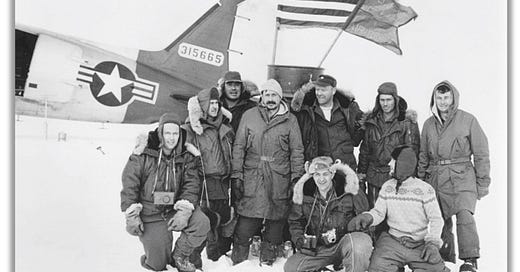TDIH: First landing at the North Pole
Did you know that the Air Force and the Navy were informally racing to be the first to land a plane at the North Pole? The Navy stumbled, giving the Air Force an opening.
On this day in 1974, Air Force pilot William P. Benedict passes away. Benedict is best known as the first American to land a plane at the North Pole.
Did you know that the Air Force and the Navy were informally racing to be the first to land a plane at the North Pole? The Navy ran into failure during March and April 1952. The stumble gave the Air Force a chance to squeak in with its own attempt.
Benedict was tasked with the mission, along with Lt. Col. Joseph O. Fletcher, commanding officer of the 58th Strategic Reconnaissance Squadron at Eielson Air Force Base in Fairbanks, Alaska. The two men planned their mission in less than a month.
It didn’t hurt that both had plenty of experience in Arctic conditions. Fletcher was a pilot, but he was also a meteorologist who had created weather stations on drifting icebergs in the Arctic. One of these, Ice Island T-3, was known as Fletcher’s Island, in his honor.
For his part, Benedict was known for his ability to create runways in the snow. His ability had been demonstrated at Fletcher’s Island when it was first being built. He was told to build a safe runway in the snow. “Runway will be finished Thursday,” he responded. “No sweat.”
It was finished on time, of course.
The two men would attempt their North Pole landing in an Air Force Douglas C-47, equipped with skis and wheels. Nine men, total, were to join the mission, including scientists and an Air Force crew.
Benedict and Fletcher’s first attempt didn’t go too well, and they were forced to turn back. But on May 3, 1952, Benedict smoothly landed the plane on the ice, taxiing to the North Pole. Fletcher hopped out and walked to the exact geographic North Pole.
“Operations instructions carried out,” Benedict radioed to Alaska Air Command. “No sweat.”
“From the sub-zero climes at the top of the world, the words ‘no sweat’ are becoming a motto,” newspapers soon reported.
Fletcher is widely believed to be the first person to stand precisely on the North Pole, but the claim is not without controversy. Early in the 20th century, two other American explorers traveled over land and believed they had found the North Pole. Nevertheless, modern scientists have reconstructed those trips and believe that neither man actually made it. Admiral Robert E. Peary’s 1909 polar expedition came the closest, but he was probably about 30 miles short of his goal.
Either way, Benedict and his crew stayed at the North Pole for 3 hours and 10 minutes that day. They took measurements to determine the depth of the ocean under the ice. They planted an American flag and an Air Force banner. They took ice samples, which would be used to determine how far the ice had floated to reach the North Pole. Finally, they left behind several air-tight bottles with messages inside. Those who find the bottles in future years are asked to report the time and place of discovery.
The mission was a complete success, but perhaps the Navy got the last laugh after all?
Just six years later, the Navy sent a submarine under the North Pole. Naturally, that is a story for another day.
P.S. It doesn't feel right to wrap up this story without noting that Benedict died a hero.... He was engaged in firefighting efforts in California when his plane crashed. RIP, Sir.
Sources can always be found on my website, here.





Thank you Tara. Col's Benedict and Fletcher were very brave to have landed a plane at the North Pole and to return safely. A first for the Air Force.
That's cold, Betsy Tara Ross! 😂🤔🤣🤯😊